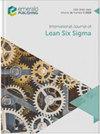Lean implementation barriers in the apparel industry in Bangladesh
IF 3.8
2区 工程技术
Q2 ENGINEERING, INDUSTRIAL
引用次数: 0
Abstract
Purpose In the highly competitive business landscape, manufacturing firms need to adopt an effective manufacturing strategy to attain a successful world-class manufacturing status. Over the past few decades, the lean manufacturing (LM) approach has gained recognition as one of the foremost strategies for enhancing performance. However, the implementation of LM poses significant challenges due to several barriers. The purpose of this paper is to investigate the primary barriers to lean implementation within the apparel industry. Design/methodology/approach This paper used an exploratory study approach, using a three-part structured questionnaire to assess the level of agreement on different lean barriers. The measurement of these barriers was conducted using a five-point Likert scale. Empirical data were collected from 177 apparel companies located in Bangladesh. Findings The findings of the research highlight that the primary obstacles to implementing LI include a lack of understanding of the lean manufacturing system (LMS), the manufacturing process, the company culture and resistance from employees. Research limitations/implications This paper could potentially limit the generalizability of this research, as it exclusively examines a single manufacturing sector – the apparel industry. Practical implications This paper will help practitioners in finding solutions to resolve discrepancies between current manufacturing practices and the LMS. Originality/value This paper fulfills an identified need to examine the extent of lean adoption within the apparel industry of Bangladesh.孟加拉国服装业实施精益生产的障碍
目的 在竞争激烈的商业环境中,制造企业需要采取有效的制造战略,才能成功跻身世界级制造企业行列。过去几十年来,精益生产(LM)方法已被公认为提高绩效的最重要战略之一。然而,由于存在若干障碍,精益生产的实施面临着巨大挑战。本文旨在调查服装行业实施精益生产的主要障碍。本文采用探索性研究方法,通过三部分结构化问卷来评估对不同精益生产障碍的认同程度。采用李克特五点量表对这些障碍进行测量。研究结果研究结果表明,实施精益生产的主要障碍包括缺乏对精益生产系统(LMS)、生产流程、公司文化的了解以及员工的抵制。研究局限性/意义本文仅研究了服装行业这一单一的制造行业,因此可能会限制本研究的推广性。原创性/价值本文满足了研究孟加拉国服装行业精益生产应用程度的需求。
本文章由计算机程序翻译,如有差异,请以英文原文为准。
求助全文
约1分钟内获得全文
求助全文
来源期刊

International Journal of Lean Six Sigma
Engineering-Industrial and Manufacturing Engineering
CiteScore
8.90
自引率
15.00%
发文量
46
期刊介绍:
Launched in 2010, International Journal of Lean Six Sigma publishes original, empirical and review papers, case studies and theoretical frameworks or models related to Lean and Six Sigma methodologies. High quality submissions are sought from academics, researchers, practitioners and leading management consultants from around the world. Research, case studies and examples can be cited from manufacturing, service and public sectors. This includes manufacturing, health, financial services, local government, education, professional services, IT Services, transport, etc.
 求助内容:
求助内容: 应助结果提醒方式:
应助结果提醒方式:


